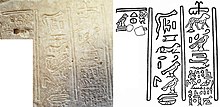Graffito of Esmet-Achom
The graffito of Esmet-Achom (or Philae 436 ) contains the last datable inscription in Egyptian hieroglyphics . It is located on the northern inner wall of Hadrian's Gate (also Hadrian's Bastion), built next to the west side of the Temple of Isis on the island of Philae in Egypt . After the entire temple complex was relocated , the remains of the gate are now on the island of Agilkia.
It depicts the Nubian god Mandulis , next to whom two inscriptions were engraved in the stone. On the right of his crowned head there is a hieroglyphic inscription in three columns , while on the right below his outstretched arm a demotic inscription indicates the celebration of the birthday of the god Osiris in 110 after the assumption of reign of the Roman emperor Diocletian in 284 AD. This results in August 24th in the year 394 AD as the date on which the graffito was affixed . Although there are still some later demotic texts on the island, this is the last text that explicitly mentions the god Osiris.
Historical context
In 392 AD, Emperor Theodosius I , who made Christianity the de facto state religion in the Roman Empire , ordered the closure of all temples in Egypt by edict. Although Philae had also had a Christian community since the 4th century, the Temple of Isis remained in existence until around AD 535 for political reasons.
Only between 535 and 537 did the Byzantine Emperor Justinian I forcibly close the temple, although the Nubian Blemmyes still held on to the worship of the sanctuary. The rear area of the pillared room was consecrated as a church to Saint Stephen around 553 and a large number of the reliefs in the temple were destroyed on this occasion. The image of the Manduli at Hadrian's Gate was also hacked out, except for his crown, the apron and the ankh sign in his hand.
Inscriptions
Hieroglyphic inscription
Inscription:
m-b3ḥ Mrwr s3 Ḥr.w m-ˁ = f 3s.t-md-jḫm s3 3s.t-md ḥm-nṯr-sn.nw n 3s.t ḏ.t nḥḥ ḏd-mdw.w jn Mrwr nb j3 .t-wˁb.t nṯr ˁ3
Translation:
“Before Mandulis, son of Horus, [made] by Esmet-Achom, son of Esmet, second ḥm priest of Isis, for all eternity. To be recited by Mandulis, the Lord of Abaton, the great God. "
Demotic inscription
Translation:
“I am Esmet-Achom, scribe of the Isis House of Scriptures, son of Esmet-Panechetut, the second ḥm priest of Isis; whose mother is Asetweret. I carried out the work on this Mandulis picture for eternity because he is benevolent towards me. On the birthday of Osiris, on the feast of the same, in the 110th year. "
Web links
- Ultima iscrizione geroglifica. cartigli.it, 2012(Italian).
- Karl Mustafa: The last hieroglyphs. Sen-nefer, 2017 .
Individual evidence
- ^ Marl Smith: Following Osiris Perspectives on the Osirian Afterlife from Four Millennia. Oxford University Press, Oxford 2017, ISBN 978-0-19-958222-8 , p. 456.
- ^ A b Günther Hölbl : Ancient Egypt in the Roman Empire: The Roman Pharaoh and his temples . tape 1 : Roman politics and ancient Egyptian ideology from Augustus to Diocletian, temple building in Upper Egypt . von Zabern, Mainz 2000, ISBN 978-3-8053-2392-5 , p. 46 .
Coordinates: 24 ° 1 ′ 32.5 ″ N , 32 ° 53 ′ 2 ″ E



